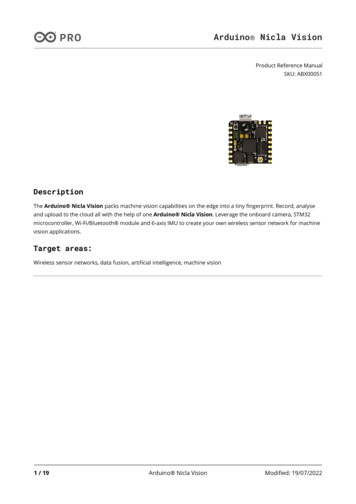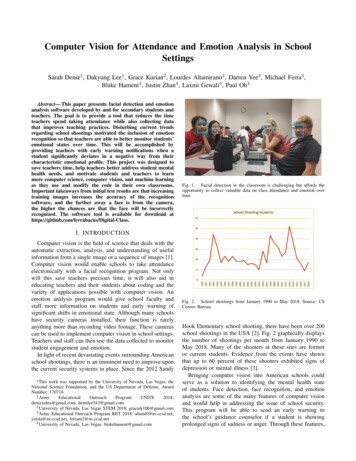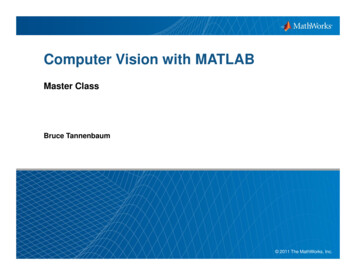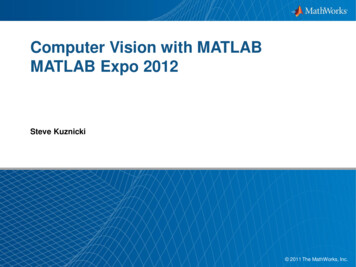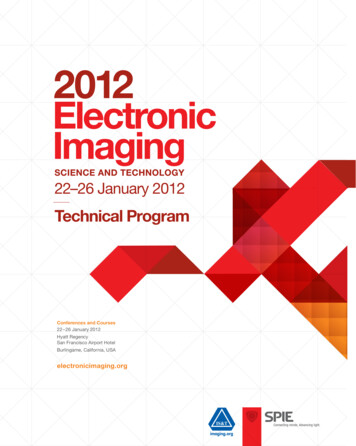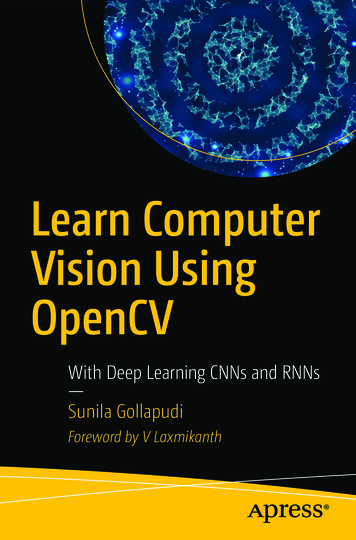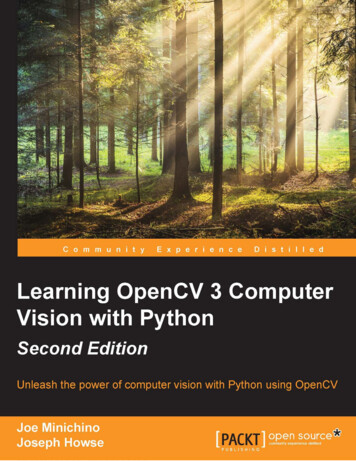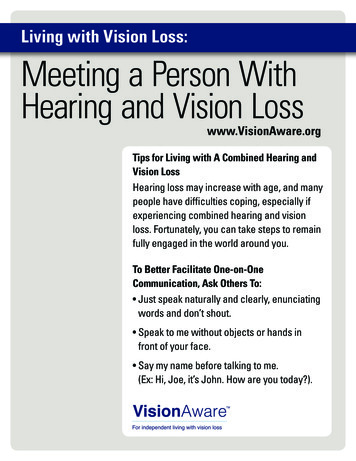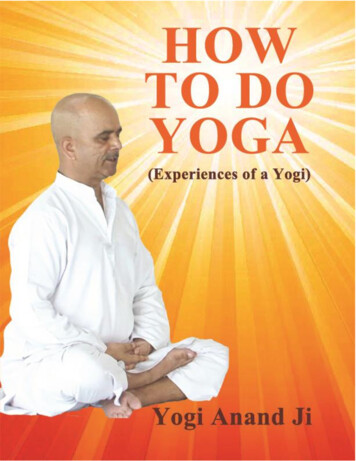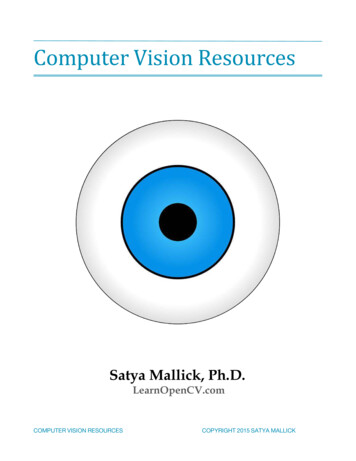
Transcription
Computer Vision ResourcesSatya Mallick, Ph.D.LearnOpenCV.comCOMPUTER VISION RESOURCESCOPYRIGHT 2015 SATYA MALLICK
Author's NoteCongratulations! By downloading this resource guide, you have embarked on a journeyof learning. This guide is not a laundry list of all available computer vision resources.On the contrary, it is a curated list of things I find useful in my work. It is often wise toleave out ingredients from a recipe to improve it, and so I have decided to leave outresources that may overwhelm a beginner. However, if you do have a resource that youfind useful, please email me at spmallick@learnopencv.comWho is this guide for?This guide is for programmers, hackers, engineers, scientists, students, and self-starters.It is for those creative people who have an itch to learn something new and buildsomething useful and beautiful. It is for people who take pride in their work and arecraftsmen at heart. It is for men and women who believe in sharpening their tools andimproving their craft on a regular basis. It is for those who believe that learning is acontinuous process, and that there are smart ways to learn fast. It is for tinkerers whocan learn by reading but prefer to learn by doing. Lastly, it is for people who invest inthemselves by learning something new every day and are eager to contribute back tothe community to enrich others!COMPUTER VISION RESOURCESCOPYRIGHT 2015 SATYA MALLICK
Books1. Computer Vision: Algorithms andApplicationsAuthor: Richard SzeliskiSummary: This is by far the best book oncomputer vision I have used. This is a good basicreference book for a wide variety of computervision topics — image formation, image processing,feature detection and matching, imagesegmentation, image alignment, structure frommotion, motion estimation, image stitching,computational photography, stereocorrespondence, 3D reconstruction, image basedrendering, and recognition.Free version: http://szeliski.org/Book/Buy at Amazon (Hardcover)COMPUTER VISION RESOURCESCOPYRIGHT 2015 SATYA MALLICK
2. Digital Image ProcessingAuthors: Rafael C. Gonzalez and Richard E. WoodsSummary: This is a good introductory book inimage processing. It may be challenging tounderstand Computer Vision literature without abasic understanding of image processing concepts.The book covers digital image fundamentals, imageenhancement (spatial and frequency domains),image restoration, color image processing, waveletsand multi-resolution processing, imagecompression, morphological operations,segmentation, and a bit of object detection.Buy at Amazon (Hardcover and Paperback)3. Learning OpenCVAuthors: Gary Bradski & Adrian KaehlerSummary: Gray Bradski started OpenCV andthis book is a great introductory book forlearning OpenCV. The book comes with links tocode samples and tutorials. The only downsideis that this version of the book does not coverOpenCV 3.Note: The examples in the book are in C only.Buy at AmazonCOMPUTER VISION RESOURCESCOPYRIGHT 2015 SATYA MALLICK
4. Practical Python and OpenCVAuthors: Adrian RosebrockSummary: Great introductory book for learningOpenCV using Python. It contains examplecode, and interesting case studies. This digitalbook comes with a 30-day money backguarantee, so it is risk free! You also receive freeupdates to the book as it is revised (e.g. whenOpenCV 3 is released some of the code will berevised).Buy at PyImageSearch.comCOMPUTER VISION RESOURCESCOPYRIGHT 2015 SATYA MALLICK
Python Books1.Fluent PythonAuthors: Luciano RamalhoSummary: Great book on effective, idiomaticPython. However, it is not a basic book - if youdo not know the Python language at all, it willbe too complex for youBook at O’Reilly store2.From Python to NumpyAuthors: Nicolas P. RougierSummary: If you already know Python andneed to use the NumPy superpower, this bookis for you! Nicolas has done the great jobdescribing the tips and tricks of NumPystarting from the basics and up to the mastery.Link to the free copy of the bookCOMPUTER VISION RESOURCESCOPYRIGHT 2015 SATYA MALLICK
3.Effective PythonAuthor: Brett SlatkinSummary: This second edition book providesinsight into the “Pythonic” way of writingprograms: the best way to use Python. Theauthor brings together 90 Python bestpractices, tips, and shortcuts, and explainsthem with realistic code examples so that youcan embrace Python with confidence.Note: All of the examples from the book couldbe found in the github repo.Buy at Amazon4.High Performance PythonAuthor: Ian Ozsvald, Micha GorelickSummary: By exploring the fundamentaltheory behind design choices, this practicalguide helps you gain a deeper understandingof Python’s implementation. You will learnhow to locate performance bottlenecks andsignificantly speed up your code in high-datavolume programs.Book at O’Reilly storeCOMPUTER VISION RESOURCESCOPYRIGHT 2015 SATYA MALLICK
PyTorch books1.Deep Learning with PyTorchAuthors: Eli Stevens, Luca AntigaSummary: Deep Learning with PyTorchprovides a detailed, hands-on introduction tobuilding and training neural networks withPyTorch. It includes: Introduction to deep learning and thePyTorch library Pre-trained networks Tensors The mechanics of learning Using a neural network to fit dataLink to the free copy of the bookCOMPUTER VISION RESOURCESCOPYRIGHT 2015 SATYA MALLICK
2.Deep Learning with PyTorch1.x: Implement deep learningtechniques and neural networkarchitecture variants using Python,2nd EditionAuthors: Laura Mitchell, Sri. Yogesh K.,Vishnu SubramanianSummary: Freshly published in November2019, this book provides the fundamentalaspects that power modern deep learning andcovers the new features of the PyTorch 1.xlibrary.Buy at AmazonDL books1.Deep LearningAuthors: Ian Goodfellow, Yoshua Bengio,Aaron Courville.Summary: This book is widely regarded asDeep Learning's "Bible". This is probably themost detailed book you can read on DeepLearning and Neural Nets, written by threeexperts, including one of the field's godfathers.The book is quite technical, but in describingeverything you need to learn to get going, thewriters did a great job.Free online versionBuy at AmazonCOMPUTER VISION RESOURCESCOPYRIGHT 2015 SATYA MALLICK
2.Python Deep Learning:Exploring deep learning techniquesand neural network architectureswith PyTorch, Keras, and TensorFlowAuthors: Ivan Vasilev, Daniel Slater,Gianmario Spacagna, Peter Roelants, ValentinoZoccaSummary: This book will get you up to speedwith deep learning, deep neural networks, andhow to train them with the most popularPython frameworks. It provides not only indetail explanation of the basics of neuralnetworks, but gradually introduces morecomplex models like recurrent networks andGANs in an easy to understand manner.Buy at AmazonCOMPUTER VISION RESOURCESCOPYRIGHT 2015 SATYA MALLICK
Online resources https://distill.pub/ - cool visualizations https://www.youtube.com/watch?v aircAruvnKk - youtube channel of3 Blue 1 Brown with neural networks explained by visual examples https://www.youtube.com/user/keeroyz/videos?sort p&view 0&flow grid - Two Minute Papers' Channel provides an interesting and shallowoverview of some deep learning research papers http://www.arxiv-sanity.com/ - aggregator of papers from arXiv.comthat allows researchers to keep track of recent or popular papers ondifferent themes of Machine Learning https://pytorch.org/tutorials/ - official tutorials on using PyTorch fromthe creators https://github.com/vinhkhuc/PyTorch-Mini-Tutorials - mini-tutorials onPyTorch to get to know the framework set-examples some custom dataset examples for PyTorch ing-in-pytorch - ahands-on deep learning intro with some explanation of the mathematicsbehindCOMPUTER VISION RESOURCESCOPYRIGHT 2015 SATYA MALLICK
Software & LibrariesOpenCV ( http://opencv.org/ )SummaryThe biggest and the most extensive open source computer vision library.OpenCV has more than 47 thousand people of user community and estimatednumber of downloads exceeding 10 million.LanguagesC/C with interfaces to Python and Java.PlatformsWindows, Linux, Mac OS, iOS, Android, Raspberry Pi, and NVIDIA Jetson TK1.License ( http://opencv.org/license.html )BSD: It is free for both academic and commercial use.Note: Not all parts of OpenCV are free.VLFeat ( http://www.vlfeat.org/ )SummaryComputer vision algorithms specializing in image understanding and localfeatures extraction and matching.LanguagesC with interfaces in MATLABPlatformsWindows, Mac OS X, and Linux.LicenseBSD: It is free for academic and commercial use.SimpleCV ( http://simplecv.org/ )SummarySimpleCV is an open source wrapper around computer vision libraries such asOpenCV that hides some of its complexities.LanguagesPythonPlatformsCOMPUTER VISION RESOURCESCOPYRIGHT 2015 SATYA MALLICK
Windows, Mac OS X, Linux, and Raspberry Pi.LicenseBSD: It is free for academic and commercial use.MATLAB CV r-vision/ )SummaryA computer vision toolbox for MATLAB.LanguagesMATLABPlatformsWindows, Mac OS X and Linux.LicenseMATLAB's license. Requires Image Processing Toolbox. The total cost ofinstalling MATLAB ( 2,150) Image Processing Toolbox ( 1, 000) Computer VisionToolbox ( 1,350) 4500. Student licenses are much cheaper though (few hundreddollars).Python LibrariesOne of the main advantages of using OpenCV with Python is the vast number ofscientific libraries available for Python. Here are a few libraries you will find useful. Thefirst three libraries — NumPy, SciPy and Matplotlib — are part of the SciPy stack. Whenused together, they pretty much replace MATLAB.1. NumPy ( http://www.numpy.org ) : NumPy adds support for large, multidimensional arrays and matrices to Python. It also consists of a large library ofhigh-level mathematical functions to operate on these arrays. OpenCV imagesare read in as NumPy arrays. Several other math, image processing, and machinelearning libraries are built on top of NumPy.2. SciPy ( http://scipy.org/scipylib/index.html ) : SciPy is a powerful scientificlibrary built on top of NumPy. It’s sub packages include linalg ( linear algebra ),optimize ( optimization and root-finding routines ), stats ( statistical distributionsand functions ), ndimage ( N-dimensional image processing ), interpolate (interpolation and smoothing splines) , fftpack ( Fast Fourier Transformroutines), cluster (Clustering algorithms) and many more.COMPUTER VISION RESOURCESCOPYRIGHT 2015 SATYA MALLICK
3. matplotlib ( http://matplotlib.org/ ) : An excellent 2D plotting library forPython that is every bit as powerful as MATLAB. You can generate plots,histograms, power spectra, bar charts, scatterplots, etc, with just a few lines ofcode.4. scikit-learn ( http://scikit-learn.org/ ) : As a computer vision programmer /engineer, you will inevitably need a good machine learning library and scikitlearn serves that purpose well. It uses numpy/scipy idioms and providesalgorithms for preprocessing data, classification, regression, clustering,dimensionality reduction, and model selection.PyTorch LibrariesHere is a list of handy libraries to help you with developing under PyTorch framework.1. Albumentations ( https://albumentations.readthedocs.io/ ) : A fast imageaugmentation library based on highly-optimized OpenCV library. Super simpleyet powerful interface for different tasks (like segmentation, detection, etc.), thatcould be easily customized. Even though the library could be used not onlyunder PyTorch framework, it has PyTorch helpers in its submodulealbumentations.pytorch to make working with PyTorch tensors as easy aspossible.2. Tensorboard ( https://www.tensorflow.org/tensorboard/ ) : Starting withversion 1.2 PyTorch integrates with TensorBoard, a tool designed for visualizingthe results of neural network training runs. It comes extremely helpful to seewhat’s happening during your training. It provides tracking and visualizingmetrics such as loss and accuracy, visualizing the model graph (ops and layers),viewing histograms of weights, biases, or other tensors as they change over time,displaying images, text, and audio data and much more.3. Weights & biases ( https://www.wandb.com/ ) : This is an experiment trackingtool for machine learning. Its background process collects useful data about whatis happening as you train your models. For example, it can track modelperformance metrics, hyperparameters, gradients, system metrics, output files,and your most recent git commit. Again, like in case of the Albumentationslibrary, Weights & biases is framework agnostic.COMPUTER VISION RESOURCESCOPYRIGHT 2015 SATYA MALLICK
4. MMDetection ( https://github.com/open-mmlab/mmdetection ) : MMDetectionis an object detection toolbox based on PyTorch that contains a rich set of objectdetection and instance segmentation methods. It started from a codebase ofMMDet team who won the detection track of COCO Challenge 2018. It graduallyevolves into a unified platform that covers many popular detection methods. Bynow it provides weights for more than 200 network models.5. Fast.ai ( https://www.fast.ai/ ) : The fast.ai library could be thought of as anindependent framework, based on PyTorch. It simplifies training fast andaccurate neural nets. For doing so, it uses modern best practices, including "outof the box" support for vision, text, tabular, and collaborative filtering models.Web APIs1. Alchemy API : A deep learning based API for auto tagging images based on thecontent of the image. If you upload an image of a cat, it will return “cat” as a tag.Deep learning based large-scale recognition is a hot topic of research these days.If you have been following ImageNet Large Scale Visual RecognitionChallenge ( ILSVRC ), you probably know that even though IBM is first tomarket with its API, several other teams from Google, Facebook, Microsoft,Baidu, and several universities are doing much better in the competition. Hopethey come up with an API too!2. CloudSight ( http://cloudsightapi.com/) : What is better than computer vision ?Well, human vision! CloudSight API does visual recognition using a combinationof computer vision and human crowd sourcing. You can use their app calledCamFind to see how well it works.3. Face ( http://www.faceplusplus.com/ ) : An API for face detection, faciallandmark detection, face search, and face recognition.4. TinEye ( https://services.tineye.com/TinEyeAPI ) : Search the entire web for animage using TinEye’s reverse image search.5. OCRSDK ( http://ocrsdk.com ) : Upload an image containing text and get backthe results as text. They provide sample code and it works well for standardscanned text.COMPUTER VISION RESOURCESCOPYRIGHT 2015 SATYA MALLICK
6. CloudCV ( http://cloudcv.org ) : CloudCV describes itself as a Large-ScaleDistributed Computer Vision as a Cloud Service. It is not a commercial product,but is being developed by Machine Learning and Perception Lab at VirginiaTech. They do image stitching and object detection / classification in the cloud.My Contact /in/satyamallickCOMPUTER VISION RESOURCESCOPYRIGHT 2015 SATYA MALLICK
3. Learning OpenCV Authors: Gary Bradski & Adrian Kaehler Summary: Gray Bradski started OpenCV and this book is a great introductory book for learning OpenCV. The book comes with links to code samples and tutorials. The only downside is that this version of the book does not cover OpenCV 3. Note: The examples in the book are in C only. Buy at .


